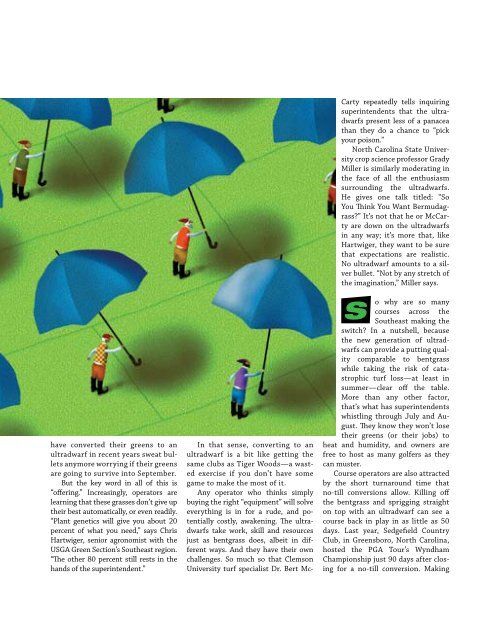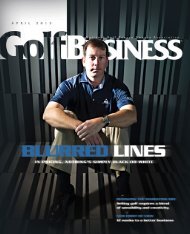Community - GolfBusiness
Community - GolfBusiness
Community - GolfBusiness
You also want an ePaper? Increase the reach of your titles
YUMPU automatically turns print PDFs into web optimized ePapers that Google loves.
have converted their greens to an<br />
ultradwarf in recent years sweat bullets<br />
anymore worrying if their greens<br />
are going to survive into September.<br />
But the key word in all of this is<br />
“offering.” Increasingly, operators are<br />
learning that these grasses don’t give up<br />
their best automatically, or even readily.<br />
“Plant genetics will give you about 20<br />
percent of what you need,” says Chris<br />
Hartwiger, senior agronomist with the<br />
USGA Green Section’s Southeast region.<br />
“The other 80 percent still rests in the<br />
hands of the superintendent.”<br />
In that sense, converting to an<br />
ultradwarf is a bit like getting the<br />
same clubs as Tiger Woods—a wasted<br />
exercise if you don’t have some<br />
game to make the most of it.<br />
Any operator who thinks simply<br />
buying the right “equipment” will solve<br />
everything is in for a rude, and potentially<br />
costly, awakening. The ultradwarfs<br />
take work, skill and resources<br />
just as bentgrass does, albeit in different<br />
ways. And they have their own<br />
challenges. So much so that Clemson<br />
University turf specialist Dr. Bert Mc-<br />
Carty repeatedly tells inquiring<br />
superintendents that the ultradwarfs<br />
present less of a panacea<br />
than they do a chance to “pick<br />
your poison.”<br />
North Carolina State University<br />
crop science professor Grady<br />
Miller is similarly moderating in<br />
the face of all the enthusiasm<br />
surrounding the ultradwarfs.<br />
He gives one talk titled: “So<br />
You Think You Want Bermudagrass”<br />
It’s not that he or McCarty<br />
are down on the ultradwarfs<br />
in any way; it’s more that, like<br />
Hartwiger, they want to be sure<br />
that expectations are realistic.<br />
No ultradwarf amounts to a silver<br />
bullet. “Not by any stretch of<br />
the imagination,” Miller says.<br />
S<br />
o why are so many<br />
courses across the<br />
Southeast making the<br />
switch In a nutshell, because<br />
the new generation of ultradwarfs<br />
can provide a putting quality<br />
comparable to bentgrass<br />
while taking the risk of catastrophic<br />
turf loss—at least in<br />
summer—clear off the table.<br />
More than any other factor,<br />
that’s what has superintendents<br />
whistling through July and August.<br />
They know they won’t lose<br />
their greens (or their jobs) to<br />
heat and humidity, and owners are<br />
free to host as many golfers as they<br />
can muster.<br />
Course operators are also attracted<br />
by the short turnaround time that<br />
no-till conversions allow. Killing off<br />
the bentgrass and sprigging straight<br />
on top with an ultradwarf can see a<br />
course back in play in as little as 50<br />
days. Last year, Sedgefield Country<br />
Club, in Greensboro, North Carolina,<br />
hosted the PGA Tour’s Wyndham<br />
Championship just 90 days after closing<br />
for a no-till conversion. Making




